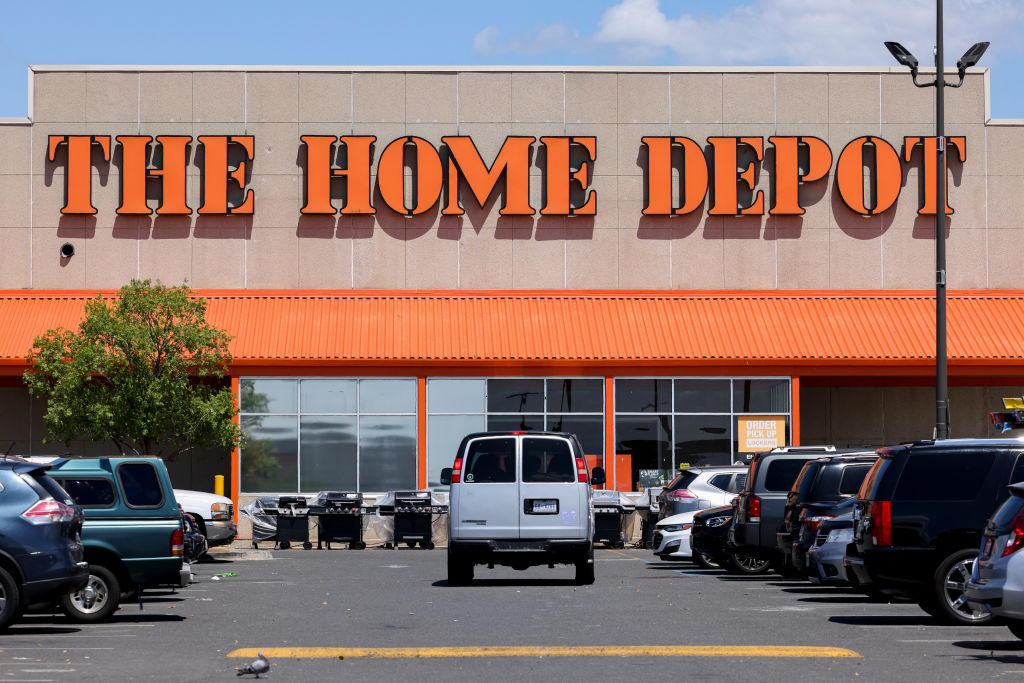Home Depot Warns of Weak Consumer Demand Ahead: What to Know
Home Depot stock is choppy Tuesday as investors parse the retailer's Q2 earnings beat and downwardly revised comparable sales forecast.


Home Depot (HD) stock is struggling for direction Tuesday after the home improvement retailer reported higher-than-expected results for its second quarter but warned of weaker consumer demand.
In the three months ended July 28, Home Depot's revenue increased 0.6% year-over-year to $43.2 billion, helped by its recent acquisition of SRS Distribution, which contributed $1.3 billion of revenue in the quarter. Its earnings per share (EPS) decreased by a penny from the year-ago period to $4.67.
Comparable sales for the quarter were down 3.3%, including a 3.6% drop in the United States.
From just $107.88 $24.99 for Kiplinger Personal Finance
Become a smarter, better informed investor. Subscribe from just $107.88 $24.99, plus get up to 4 Special Issues

Sign up for Kiplinger’s Free Newsletters
Profit and prosper with the best of expert advice on investing, taxes, retirement, personal finance and more - straight to your e-mail.
Profit and prosper with the best of expert advice - straight to your e-mail.
"The underlying long-term fundamentals supporting home improvement demand are strong," said Home Depot CEO Ted Decker in a statement. "During the quarter, higher interest rates and greater macro-economic uncertainty pressured consumer demand more broadly, resulting in weaker spend across home improvement projects. However, the team continued to navigate this unique environment while executing at a high level."
Home Depot's headline results beat analysts' expectations. Wall Street was anticipating revenue of $43.1 billion and earnings of $4.49 per share, according to CNBC. However, the comparable sales result was far worse than the 2.1% decline analysts had forecasted.
As a result of its performance in the first half and its recently completed acquisition of SRS Distribution, Home Depot updated its full-year outlook, which includes a 53rd week. The company now anticipates revenue growth in the range of 2.5% to 3.5% and earnings per share to increase between 1% to 3%. This compares with its previous forecast for revenue and EPS growth of approximately 1% apiece.
Home Depot also revised its comparable sales outlook, now anticipating a decline of 3% to 4%. The company said a 3% decline "implies a consumer demand environment consistent with the first half of fiscal 2024" while a 4% decline "implies incremental pressure on consumer demand." The company had previously forecasted comparable sales to decline approximately 1%.
Is Home Depot stock a buy, sell or hold?
Home Depot has struggled on the price charts this year, up a slight 1% on a total return basis (price change plus dividends) vs the S&P 500's 13% return. Still, Wall Street is bullish on blue chip stock.
According to S&P Global Market Intelligence, the average analyst target price for HD stock is $383.08, representing implied upside of more than 10% to current levels. Meanwhile, the consensus recommendation is a Buy.
Financial services firm Jefferies is one of the more bullish outfits on the Dow Jones stock with a Buy rating and $426 price target.
"A noisy quarter given the six-week sales contribution from recently acquired SRS, but nonetheless, the underlying trend is clear: higher interest rates and greater macroeconomic uncertainty pressured weaker spend across home improvement projects during the quarter," Jefferies analyst Jonathan Matuszewski said in a note this morning.
Jefferies' $426 price target sits almost 23% above HD's current price.
Related Content
Profit and prosper with the best of Kiplinger's advice on investing, taxes, retirement, personal finance and much more. Delivered daily. Enter your email in the box and click Sign Me Up.

Joey Solitro is a freelance financial journalist at Kiplinger with more than a decade of experience. A longtime equity analyst, Joey has covered a range of industries for media outlets including The Motley Fool, Seeking Alpha, Market Realist, and TipRanks. Joey holds a bachelor's degree in business administration.
-
 Are T-Mobile's Prepaid Perks a Home Run or a Strikeout?
Are T-Mobile's Prepaid Perks a Home Run or a Strikeout?T-Mobile's prepaid lineup promises MLB.TV, T-Mobile Tuesdays and hotspot data. But do the perks make it worth switching?
-
 Verizon Home Internet Is Offering Free Tech to New Customers
Verizon Home Internet Is Offering Free Tech to New CustomersVerizon’s latest home-internet promotion includes free tech, but the real savings depend on pricing, speed needs and how long you stay.
-
 Retirees in These 7 States Could Pay Less Property Taxes Next Year
Retirees in These 7 States Could Pay Less Property Taxes Next YearState Taxes Retirement property tax bills could be up to 65% cheaper for some older adults in 2026. Do you qualify?
-
 The November CPI Report Is Out. Here's What It Means for Rising Prices
The November CPI Report Is Out. Here's What It Means for Rising PricesThe November CPI report came in lighter than expected, but the delayed data give an incomplete picture of inflation, say economists.
-
 5 Smart Things to Do With Your Year-End Bonus, From a Financial Professional
5 Smart Things to Do With Your Year-End Bonus, From a Financial ProfessionalAfter you indulge your urge to splurge on a treat, consider doing adult things with the extra cash, like paying down debt, but also setting up a "fun fund."
-
 Are You a Gen X Investor? Here's How You Can Protect Your Portfolio From an AI Bubble
Are You a Gen X Investor? Here's How You Can Protect Your Portfolio From an AI BubbleAmid talk of an AI bubble, what's the best course of action for investors in their 50s and 60s, whose retirement savings are at risk from major market declines?
-
 Hey, Retirees: Put Your Charitable Gifts in a Donor-Advised Fund (and Enjoy Your Tax Break)
Hey, Retirees: Put Your Charitable Gifts in a Donor-Advised Fund (and Enjoy Your Tax Break)A donor-advised fund is a simple (really!), tax-smart strategy that lets you contribute a large, tax-deductible gift now and then distribute grants over time.
-
 Nasdaq Sinks 418 Points as Tech Chills: Stock Market Today
Nasdaq Sinks 418 Points as Tech Chills: Stock Market TodayInvestors, traders and speculators are growing cooler to the AI revolution as winter approaches.
-
 The Rule of Compounding: Why Time Is an Investor's Best Friend
The Rule of Compounding: Why Time Is an Investor's Best FriendDescribed as both a "miracle" and a "wonder," compound interest is simply a function of time.
-
 If You're a U.S. Retiree Living in Portugal, Your Tax Plan Needs a Post-NHR Strategy ASAP
If You're a U.S. Retiree Living in Portugal, Your Tax Plan Needs a Post-NHR Strategy ASAPWhen your 10-year Non-Habitual Resident tax break ends, you could see your tax rate soar. Take steps to plan for this change well before the NHR window closes.
-
 Stocks Chop as the Unemployment Rate Jumps: Stock Market Today
Stocks Chop as the Unemployment Rate Jumps: Stock Market TodayNovember job growth was stronger than expected, but sharp losses in October and a rising unemployment rate are worrying market participants.